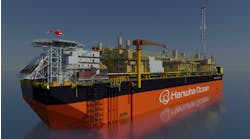James K. Dodson
James Dodson Co.
Leonard Le Blanc
Editor
Operators projected to drill 903 wells in 1999
- US Gulf leaseholder BOE revenue vs. wells drilled [40,051 bytes]
- US Gulf 1999 well forecast [3,531 bytes]
- US Gulf Top 20 leaseholders ranked by BOE produced [24,317 bytes]
- US Gulf Wells drilled 1996-1998p [7,888 bytes]
- US Gulf wells drilled 1997 11/1998 ytd [27,166 bytes]
- Deepwater Discoveries in the US Gulf of Mexico (1,500 ft) [258,844 bytes]
Producers in the US Gulf of Mexico will experience a smaller loss in cash flow in 1999, compared to 1998, as a result of higher oil production volumes and reasonably strong natural gas prices. While oil prices dropped from $16-18/bbl levels to $11-12/bbl levels in 1998, that loss was not as signficant for US Gulf leaseholders. Gas prices have remained above the $2/Mcf mark.
Leasehold revenue from 354 leaseholders for 1999 is projected at $14 billion (see accompanying table), which collectively is down $915
million from the $15 billion projected in 1998.
This modest loss (6%) in revenue flow is reflected in modestly (10%) lower well numbers projected for drilling in 1999. Operators are expected to drill 903 wells in 1999, compared with 1,003 wells projected for all of 1998 (projected from totals in the first 11 months of 1998).
The 903 wells projected for 1999 will be down over 25% from the 1,217 wells drilled in 1997. Most of the slowdown in drilling took place in the final six months of 1998, as producers
factored in the developing weakness in oil prices and expiration of drilling rig contracts.
At least part of the falloff in drilling in 1999 can be attributed to consolidation among producers - Kerr-McGee-Oryx, Ocean Energy-UMC, Union Pacifc Resources-Norcen, Burlington-LL&E, and Sonat-Zilkha, for example.
Helping to reduce the impact of weaker oil prices is the higher volume of oil produced in the US Gulf, a condition that largely mirrored producer responses to lower oil prices around the world, and probably the reason why the oil price collapse has endured. Oil production in the US Gulf was up 53 million bbl in 1998, compared with 1997.
After passing through most of the reduction in oil prices through to lower funding for drilling and development activities, producers are likely to benefit greatly from rising oil prices in 1999, also projected to take place. Oil prices are estimated to average about $13/bbl for all of 1999. The upward movement in oil prices could develop in the latter half of 1999. Gas prices are expected to average at least $2.25/Mcf during 1999.
Well forecast
The projected 903 wells for 1999 in the US Gulf is a product of estimation mostly from recent drilling history, but also producer plans and oil and gas pricing models. Drilling from January 1, 1998 through November 30, 1998 resulted in a total of 914 wells, compared with a total of 1,134 for the same 11-month period in 1997.Of the 903 wells projected to be drilled in 1999 in federal OCS and state waters, 406 are projected as exploration and 497 are projected for development. In terms of well type, the 903 wells are divided into 221 oil wells, 411 gas wells, and 271 projected as dry.
Top drillers
Most operators pulled back on drilling substantially in the US Gulf of Mexico in 1998, compared with the number of wells drilled in 1997. For example, Shell drilled 120 wells in 1997, but had only drilled 73 wells in 1998 for the first 11 months of 1998. Chevron's drilling program was off 30 wells, from 106 wells down to 73 wells for the same period.Other producers with diminished drilling programs in 1998 were Ocean Energy, off 18 wells, Texaco, off 16 wells, Burlington, off 18 wells, Sonat Exploration, off 14 wells, Conoco, off 13 wells, and Forcenergy, off 21 wells.
Chevron and Shell (combining Shell Deep water and Shell Offshore) - were the leading drillers in the US Gulf of Mexico for 1998.
Both producers had drilled 73 wells through November.
Following these two producers was Vastar, with 48 wells drilled, Ocean Energy, with 46 wells drilled, Coastal Oil, 42 wells, Unocal, with 38 wells, and Texaco, with 30 wells.
Top BOE leaseholders
Deepwater continues to dominate production in the US Gulf of Mexico. Shell Deepwater remains the largest BOE producer in the US Gulf of Mexico through the first six months of 1998. The firm produced 51.4 million BOE through that period, compared with Chevron, which produced 47 million BOE and Exxon, with 32.8 million BOE. Texaco, with 30.9 million BOE, followed. The fifth-ranking producer - Shell Offshore, as separate from Shell Deepwater - had an output for the period of 28.1 million BOE.Shell Deepwater had no production in water depths of less than 601 ft, and only 3% of its 51.4 million BOE was produced within water depths of 601 ft and 1,499 ft. The other 97% was produced in depths of 1,500 ft and over.
By contrast, Chevron was just the opposite. Almost 98% of its production took place in water depths of less than 601 ft, and none in a water depth of 1,500 ft or greater before July, 1998.
Top gas, oil leaseholders
The largest gas producer in the US Gulf, at least through the first six months of 1998, is Chevron, with 171.8 bcf, most of which came from shallow water. Texaco followed with a production level of 123.6 bcf. Other top producers are Exxon, with 122 bcf, Shell Deepwater, with 116.4 bcf, Shell Offshore , with 112.5 bcf, and Unocal, with 90.5 bcf.The largest deepwater producer (1,500 ft and greater) is Shell Deepwater, with 108 bcf. The next two largest deepwater gas producers are CNG Producing , Exxon, and Amoco, with 11.5 bcf, 8.6 bcf, and 8.5 bcf, respectively.
The largest oil producer is Shell Deepwater, with 32 million bbl for the first six months of 1998. Chevron and Exxon followed with 18.4 million bbl and 12.3 million bbl, respectively. The fourth ranking oil producer in the US Gulf is BP Exploration, with 10.5 million bbl. Interestingly, of BP's 10.5 million bbl, 5.5 million bbl came from water depths of 1,500 ft and greater, making BP the second-ranking oil producer in any water depths beyond 601 ft.
Conclusion
Deepwater operations remain the controlling factor in the US Gulf of Mexico, although gas drilling and subsalt discoveries are keeping interest up in the shallower depths. The number of wells committed to in deepwater (1,000 ft or deeper) by producers for 1999 (150 wells) is very similar to that in 1998 (142).Funding those deepwater wells will cost $10-25 million each. Since many deepwater rigs are already under contract, funding that level of drilling could become a serious problem in 1999. Few operators other than integrated companies with good income from downstream operations will be able to meet commitments, even when the rigs become available. In jeapardy are the deepwater drilling programs of smaller operators completely dependent on upstream income.
The salvation for many operators in costly deepwater drilling is that development wells are highly productive, so producers often find they need fewer of them. The wellbeing of deepwater will continue to rely on lower-than-projected drilling cost for development.
However, without support for natural gas prices through the winter of 1998-1999, the projected well count for the US Gulf in 1999 would have been lower. Gas prices appear to be holding up, allowing a modest drawdown of supplies of crude oil, which in turn could help make a case, other than what OPEC cooperation might supply, for slightly higher oil prices later in 1999.
Copyright 1999 Oil & Gas Journal. All Rights Reserved.


